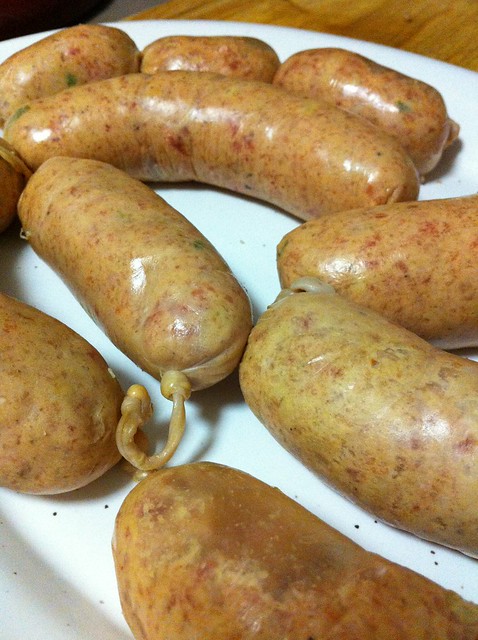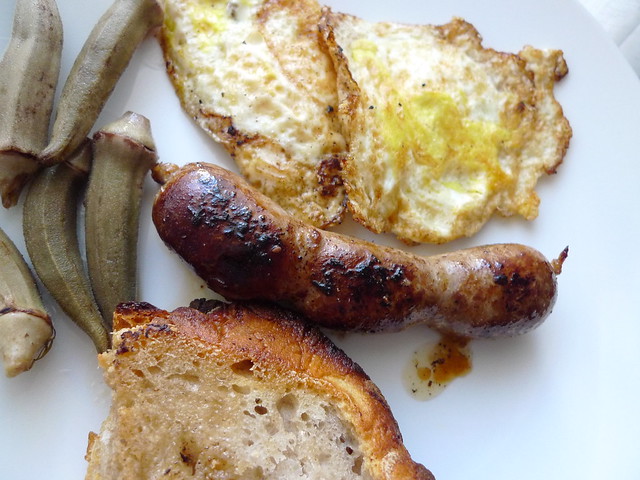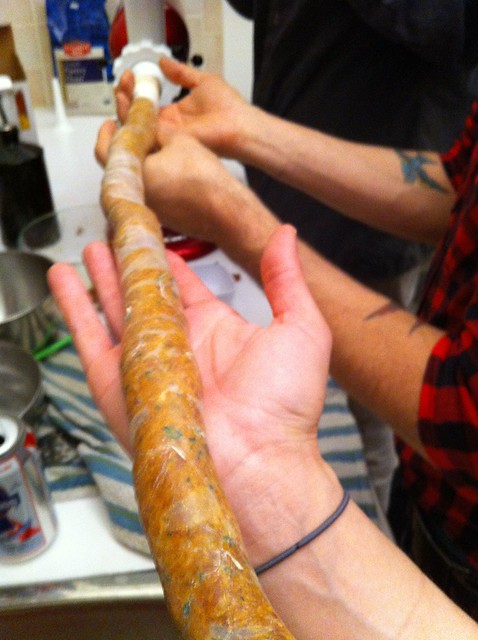Filipinos like their meat, but we especially love our pork. We love it so much that we will eat it three times a day–for breakfast, lunch and dinner. To start a traditional Filipino day, longganisa (also longaniza), or Filipino sausage, is one of the meat choices that pair up with eggs and fried rice. All three in one dish combined make longsilog: longganisa for “long”; sinangag, or fried rice, for “si”; itlog, or egg, for the “log”. All over the Philippines, you will encounter different combinations of -silogs.
I usually dash out of the apartment during the week and eat a simple breakfast of yogurt with fruit or Three Sisters cereal when I get to work, but on weekends I splurge on time and make myself a huge breakfast especially if I’m coming from a morning bike ride around Central Park. That breakfast always includes eggs and some type of meat, be it bacon or leftover steak from the night before. I rarely have cooked rice at home (it’s a lot to waste when you’re living on your own), so my fallback is usually a salad or a type of vegetable, even if it’s a pickle. Down the list of breakfast meats after bacon that I like comes longganisa because it has a touch of sweetness and tastes so damn good with a dash of vinegar. My mouth is watering just thinking of sticky-sweet longganisa and runny fried eggs on top of hot fried rice.
I promised myself that before the year ends, I will make my own sausages and use the attachments that I bought for my KitchenAid stand mixer. So during the long Thanksgiving weekend, I stayed busy in the kitchen and finally made them. I had asked my mother for a recipe because she’s originally from the province of Pampanga where longganisa is famous. She showed me an old copy of a Filipino recipe that used phosphate and food coloring! Fail! I then turned to my copy of Memories of Filipino Kitchens and substituted the rice wine and the rice vinegar for plain white vinegar and added brown sugar for the sweetness that I crave in these sausages. Their recipe also used lime zest which I thought was pretty interesting even though it got lost in the mix, so I have eliminated it from this version.
I learned a few important things when I made my own sausage links for the first time:
1. Making sausages is hard work, so another pair of hands is always helpful.
2. Keep lemon handy. The smell of meat will stay on your fingers for several hours and I found only lemon juice removed the odor.
3. White bread was invented to clean off your food grinder and sausage stuffer attachments.
This is a two-type recipe for longganisa. One is the easy way without any equipment or casings which makes the sausages naked, or hubad in Tagalog. The other is for sausage links which requires both the food grinder and sausage stuffer attachments with your KitchenAid stand mixer, plus sausage casings from your well-stocked butcher shop.
Ingredients:
2 tbsps vinegar
2 tbsps brown sugar
3 cloves garlic, minced
salt
pepper
oilIf making them naked:
1 pound pork belly, grounded
1/2 pound lean beef, grounded1. Add all ingredients together in a large mixing bowl and mix with your hands. Knead the meat until it holds together and you can shape the mixture into patties. Wrap in wax paper to store in the fridge or keep in the freezer.
2. To fry longganisa patties, heat some oil in a deep skillet. Add longganisa and fry using low-medium fire until both sides are browned. Crumble and break into pieces and serve with two eggs, preferably over easy.If making links:
1 pound pork belly, cut into 1-inch chunks
1/2 pound lean beef, cut into 1-inch chunks
sausage casings, soaked overnight in cold water, rinsed
white bread slices1. Combine all the meats with the spices except the oil. Massage with your hands to mix well. Marinate for at least an hour or overnight in the fridge.
2. When ready to make links, assemble the food grinder and sausage stuffer attachments with your mixer. Select a length of casing and run water from the tap through it in order to clear out any excess salt and spot any holes. Trim to remove the holes. Run the casing between your fingers to remove excess water. Stretch the open end of the casing around the attachment’s nozzle and gradually slide the rest of the casing onto the nozzle, an inch or 2 at a time, trying not to twist. Leave about 3 inches at the knotted end dangling free. This will be your end knot.
3. Ground the meat and stuff the casing. Put the meat mixture in the hopper of the grinder and turn it on to speed 4. Hold the dangling casing with one hand, and with the other, feed the meat into the hopper with the plastic or wooden pestle at an even pace. Your stuffer will slowly stuff the ground meat into the casing. Gently guide the rest of the casing off the nozzle to aid the stuffing of the sausage. When you have 2 inches left at the other end, stop stuffing and remove the free casing from the nozzle. This is your other end knot. Repeat this process until all of the sausage meat has been used, pushing out the last bits of meat with a slice or two of bread. Discard grounded bread.
4. Run your fingers over the casing to distribute the sausage evenly. Pinch every 3 inches or in empty spots and gently twist it to form separate links. Feel free to tie end knots.
5. To fry longganisa links, heat some oil in a deep skillet. Add longganisa and fry using low-medium fire until all sides are browned. Gently pierce empty casing that bubbles up to avoid bursts of sausages! Serve with two eggs, preferably over easy.
I realize that this is probably the longest recipe I have on this site, so I hope these photos will guide you to making your own sausages at home.
1. Stretch the open end of the casing around the attachment’s nozzle and gradually slide the rest of the casing onto the nozzle, an inch or 2 at a time, trying not to twist. Leave about 3 inches at the knotted end dangling free.
2. Hold the dangling casing with one hand, and with the other, feed the meat into the hopper with the plastic or wooden pestle at an even pace. Another pair of hands is always helpful.
3. Your stuffer will slowly stuff the ground meat into the casing. Gently guide the rest of the casing off the nozzle to aid the stuffing of the sausage.
Please excuse the innuendos from the video above (which may not show up on your phones); they made sausage-making more fun though.
Related post/s:
You can buy sausage casings from Esposito Pork Shop in New York City
Amazon.com also sells sausage casings
These will be perfect holiday gifts: KitchenAid food grinder attachment and sausage stuffer



